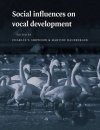![Social Influences on Vocal Development Social Influences on Vocal Development]()
Click to have a closer look
About this book
Contents
Customer reviews
Related titles
About this book
For at least 30 years, there have been close parallels between studies of birdsong development and those of the development of human language. Both song and language require species-specific stimulation at a sensitive period in development and subsequent practice through subsong and plastic song in birds and babbling in infant humans leading to the development of characteristic vocalisations for each species. This book illustrates how social interactions during development can shape vocal learning and extend the sensitive period beyond infancy and how social companions can induce flexibility even into adulthood. Social companions in a wide range of species including birds and humans but also cetaceans and nonhuman primates play important roles in shaping vocal production as well as the comprehension and appropriate usage of vocal communication. This book will be required reading for students and researchers interested in animal and human communication and its development.
Contents
1. Introduction Charles T. Snowdon and Martine Hausberger; 2. Social interaction and sensitive phases for song learning: a critical review Douglas A. Nelson; 3. Social interaction and vocal development in birds Luis F. Baptista and Sandra L. L. Gaunt; 4. Building a social agenda for the study of bird song Meredith J. West, Andrew P. King and Todd M. Freeberg; 5. Field observations, experimental design and the time and place of learning in bird songs Robert B. Payne and Laura L. Payne; 6. Vocal learning in wild and domesticated Zebra Finches: signature cues for kin recognition or epiphenomena? Richard Zann; 7. What birds with complex social relationships can tell us about vocal learning: vocal sharing in avian groups Eleanor D. Brown and Susan M. Farabaugh; 8. Social influences on song acquisition and sharing in the European starling (Sturnus vulgaris) Martine Hausberger; 9. Social influences on the acquisition of human-based codes in parrots and nonhuman primates Irene Maxine Pepperberg; 10. Vocal learning in captive bottlenose dolphins: a comparison to humans and nonhuman animals Brenda McCowan and Diana Reiss; 11. Vocal learning in cetaceans Peter L. Tyack and Laela S. Sayigh; 12. Social influences on vocal development in New World primates Charles T. Snowdon, A. Margaret Elowson and Rebecca S. Roush; 13. Some general features of vocal development in nonhuman primates Robert M. Seyfarth and Dorothy L. Cheney; 14. Social influences on vocal learning in human and nonhuman primates John L. Locke and Catherine Snow; 15. The resilience of language in humans Susan Goldin-Meadow; 16. Reciprocal interactions and the development of communication and language between parents and children Annick Jouanjean-l'Antoene; 17. Crafting activities: building social organization through language in girls' and boys' groups Marjorie Harness Goodwin; Index.
Customer Reviews
Edited By: Charles T Snowdon and Martine Hausberger
352 pages, 78 line illus, 19 tabs
'Snowdon and Hausberger have managed to create a valuable resource for the discussion of both the convergences in the strategies of vocal learning in phylogenetically distinct species and the differences in more closely related species ... an important source for all interested in putting their work in a broader perspective.' Julia Fischer, Animal Behaviour


































